New dinosaur species discovered by NCSU scientist, colleague
Two scientists, including a North Carolina State University professor who works at the North Carolina Museum of Natural Sciences, have discovered a new species of carnivorous dinosaur, the university announced Friday.
Posted — UpdatedLindsay Zanno, a paleontologist, helped discover the existence of the Siats Meekerorum, one of the three largest dinosaurs ever found in North America. They would have lived alongside and competed with small-bodied tyrannosaurs nearly 100 million years ago.
“It’s been 63 years since a predator of this size has been named from North America,” Zanno said in a news release. “You can’t imagine how thrilled we were to see the bones of this behemoth poking out of the hillside.”
Zanno and Peter Makovicky, from Chicago's Field Museum of Natural History, discovered the partial skeleton of the new predator in Utah's Cedar Mountain Formation in 2008.
The recovered skeleton belonged to a dinosaur that would have been more than 30 feet long and weighed at least four tons. Despite their giant size, the bones recovered in Utah were from a juvenile.
According to Zanno, Siats terrorized what is now Utah during the Late Cretaceous period (100 million years ago to 66 million years ago). It had been unclear which animal was the top meat-eater was in North America during this time.
The lack of fossils left paleontologists unsure about when this change happened and if tyrannosaurs outcompeted carcharodontosaurs, a group of carnivorous dinosaurs that existed between 100 and 93 million years ago, or were simply able to assume apex predator roles following carcharodontosaur extinction.
Thanks to the 2008 discovery, Zanno and Makovicky said it is now clear that Siats’ large size would have prevented smaller tyrannosaurs from taking their place atop the food chain.
"Contemporary tyrannosaurs would have been no more than a nuisance to Siats, like jackals at a lion kill. It wasn’t until carcharodontosaurs bowed out that the stage could be set for the evolution of T. rex," Zanno said.
• Credits
Copyright 2024 by Capitol Broadcasting Company. All rights reserved. This material may not be published, broadcast, rewritten or redistributed.






